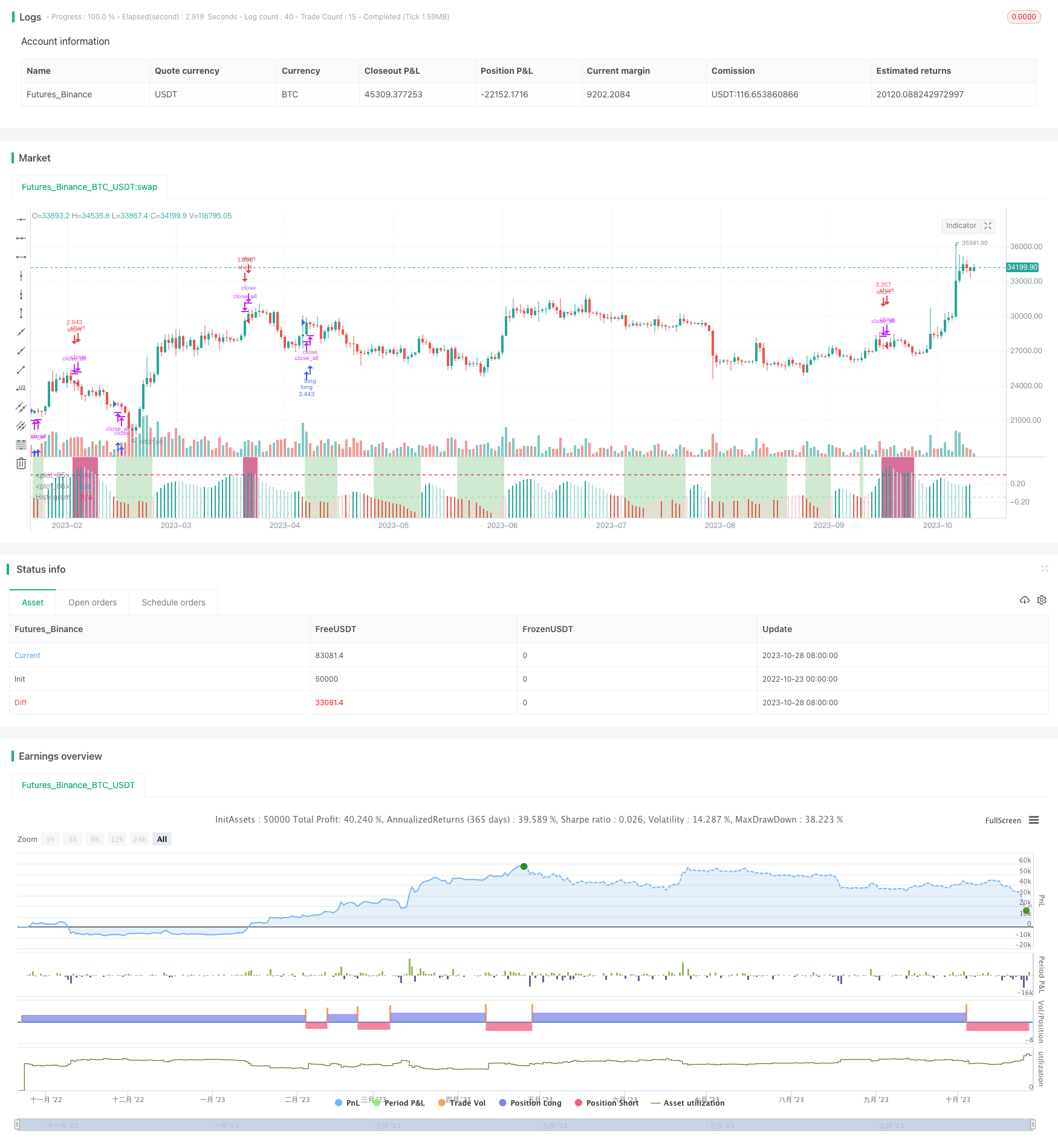
概述
该策略通过计算成交量变化率的变化率,来判断多空周期的转换,属于量价背离类策略。它结合成交量的动量指标和价格的布林带,判断成交量变化对价格的领先效应,以捕捉趋势的转折点。
策略原理
计算成交量变化率的变化率(成交量差值指标的变化率),得到基于成交量动量的指标nresult。
对nresult计算布林带,得到代表成交量动量标准差的bbr。
对收盘价计算布林带,得到代表价格标准差的bbr1。
计算两者的差值hist,即成交量动量标准差减去价格标准差,作为最终指标。
当hist上穿0时为空头入场点,下穿0时为多头入场点。
该策略通过计算成交量变化率的变化率,放大了成交量变化对价格的领先效应。当成交量出现反转,而价格还没有反转时,hist会上穿或下穿0,产生交易信号。它能提前判断价格趋势的转折点。
策略优势
该策略是基于成交量变化率的量价背离策略,能够提前反映价格趋势的转折点。
计算成交量变化率的变化率,放大了成交量变化对价格的领先效应,交易效果更优。
结合成交量动量指标与价格指标的布林带,使交易信号更可靠。
采用三次指数平滑处理Hist数据,使信号更准确、平滑。
设置超买超卖线,并配合长空停损限价单,可有效控制风险。
可自定义的参数较多,如布林带长度、标准差倍数、Hist数据平滑参数等,可进行策略优化。
策略风险
成交量数据不一定能真实反映市场交易情况,可能被操纵。
量价背离不一定持续,价格可能出现突破不反转的情况。
参数设置不当可能导致交易频繁或信号不准。
需注意防止成交量异常的假信号。
需警惕趋势坚强时的反转信号产生错误交易。
可通过优化参数,结合其他指标进行过滤,设置止损止盈确保风险可控。
策略优化方向
优化布林带参数,使信号更稳定。
结合趋势指标过滤信号,避免逆势交易。
增加其他指标确认,如MACD等,防止假信号。
利用AI技术对参数进行自适应优化。
增加止损止盈动态调整模块,优化资金管理。
结合机器学习判断量价背离成功率,提高信号质量。
总结
该策略通过计算成交量变化率的变化率,放大成交量变化对价格的领先效应,能够提前判断价格趋势的转折点。相比单一的成交量指标,具有更高的可靠性和准确性。但也需要注意防范成交量被操纵和量价背离突破的风险,通过参数优化、指标过滤等手段控制风险。未来可运用AI技术进行自适应参数优化,进一步提升策略的稳定性和收益率。
/*backtest
start: 2022-10-23 00:00:00
end: 2023-10-29 00:00:00
period: 1d
basePeriod: 1h
exchanges: [{"eid":"Futures_Binance","currency":"BTC_USDT"}]
*/
//// This source code is subject to the terms of the Mozilla Public License 2.0 at https://mozilla.org/MPL/2.0/
// © tathal and special thanks to oakwhiz for his porting of my custom volume indicator
//@version=5
strategy('Volume Difference Delta Cycle Oscillator', 'VDDC Osc', default_qty_type=strategy.percent_of_equity, default_qty_value=100, max_bars_back=5000)
startDate = input.int(title='Start Date', defval=1, minval=1, maxval=31)
startMonth = input.int(title='Start Month', defval=1, minval=1, maxval=12)
startYear = input.int(title='Start Year', defval=2010, minval=1800, maxval=2100)
endDate = input.int(title='End Date', defval=31, minval=1, maxval=31)
endMonth = input.int(title='End Month', defval=12, minval=1, maxval=12)
endYear = input.int(title='End Year', defval=2021, minval=1800, maxval=2100)
// Normalize Function
normalize(_src, _min, _max) =>
// Normalizes series with unknown min/max using historical min/max.
// _src : series to rescale.
// _min, _min: min/max values of rescaled series.
var _historicMin = 10e10
var _historicMax = -10e10
_historicMin := math.min(nz(_src, _historicMin), _historicMin)
_historicMax := math.max(nz(_src, _historicMax), _historicMax)
_min + (_max - _min) * (_src - _historicMin) / math.max(_historicMax - _historicMin, 10e-10)
// STEP 2:
// Look if the close time of the current bar
// falls inside the date range
inDateRange = true
// Stop loss & Take Profit Section
l_sl_inp = input(2.0, title='Long Stop Loss %') / 100
l_tp_inp = input(4.0, title='Long Take Profit %') / 100
l_stop_level = strategy.position_avg_price * (1 - l_sl_inp)
l_take_level = strategy.position_avg_price * (1 + l_tp_inp)
s_sl_inp = input(2.0, title='Short Stop Loss %') / 100
s_tp_inp = input(4.0, title='Short Take Profit %') / 100
s_stop_level = strategy.position_avg_price * (1 + s_sl_inp)
s_take_level = strategy.position_avg_price * (1 - s_tp_inp)
src = close
// Volume Differnce Indicator Delta
float change_src = ta.change(src)
float i_obv = ta.cum(change_src > 0 ? volume : change_src < 0 ? -volume : 0 * volume)
float i_pvt = ta.pvt
float result = ta.change(i_obv - i_pvt)
float nresult = ta.ema(normalize(result, -1, 1), 20)
// Volume Differnce Indicator Delta %B
length = input.int(20, minval=1, title='Volume Bands Length')
mult = input.float(2.0, minval=0.001, maxval=50, title='Volume Bands StdDev')
basis = ta.ema(nresult, length)
dev = mult * ta.stdev(nresult, length)
upper = basis + dev
lower = basis - dev
bbr = (nresult - lower) / (upper - lower)
// Normal %B, Based on close
l1 = input.int(20, minval=1, title='Bollinger Bands Length')
src2 = close
mult1 = input.float(2.0, minval=0.001, maxval=50, title='Bollinger Bands StdDev')
basis1 = ta.sma(src2, l1)
dev1 = mult1 * ta.stdev(src2, l1)
upper1 = basis1 + dev1
lower1 = basis1 - dev1
bbr1 = (src - lower1) / (upper1 - lower1)
/// Final Output Line
hist = ta.ema(ta.ema(ta.ema(bbr1 - bbr, input(2, title='Hist Smoothing Factor #1')), input(2, title='Hist Smoothing Factor #2')), input(2, title='Hist Smoothing Factor #3'))
/// Overbought / Oversold Line Creation
oversold = input(-.1)
overbought = input(.4)
hline(oversold, linewidth=2, color=color.new(#81c784, 62))
hline(overbought, linewidth=2, color=color.new(#c2185b, 38))
/// Long & Short Conditions
short = hist > overbought
long = hist < oversold
/// Colors & Plotting
histColor = hist >= 0 ? hist[1] < hist ? #26A69A : #B2DFDB : hist[1] < hist ? #FFCDD2 : #EF5350
plot(hist, title='Histogram', style=plot.style_columns, color=color.new(histColor, 0))
CrossBgColor = long ? color.new(#81c784, 62) : short ? color.new(#c2185b, 38) : na
bgcolor(color.new(CrossBgColor, 90))
/// Strategy Methodology
if inDateRange
strategy.entry('long', strategy.long, when=long, stop=l_stop_level, limit=l_take_level)
if inDateRange and strategy.position_size > 0
strategy.close_all(when=short)
if inDateRange
strategy.entry('short', strategy.short, when=short, stop=s_stop_level, limit=s_take_level)
if inDateRange and strategy.position_size < 0
strategy.close_all(when=long)